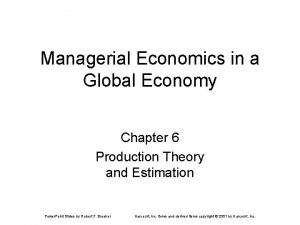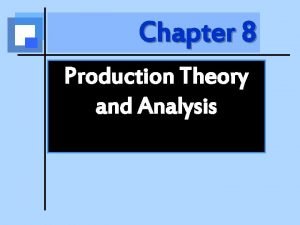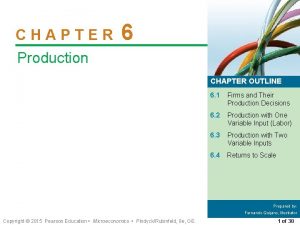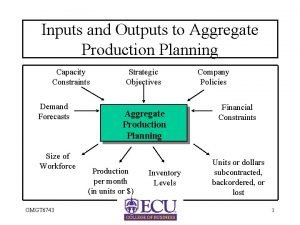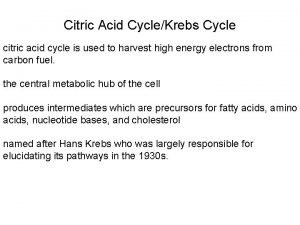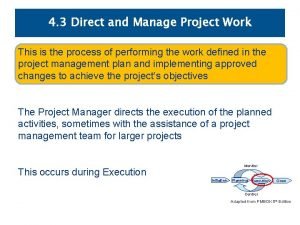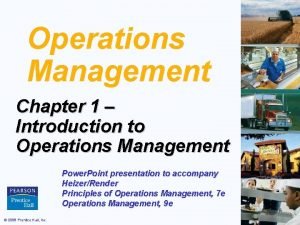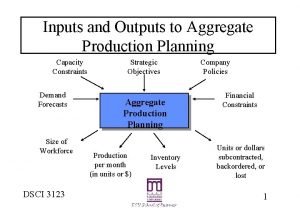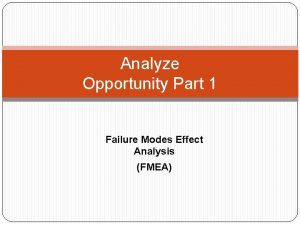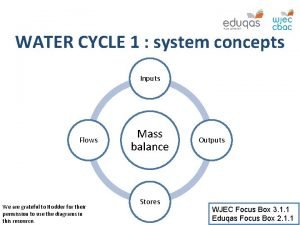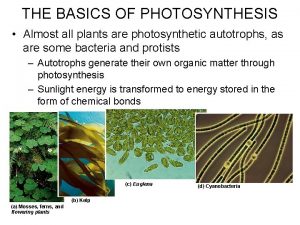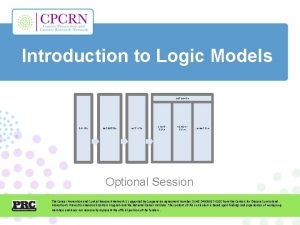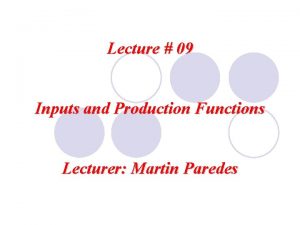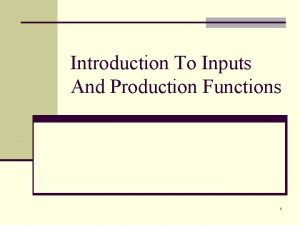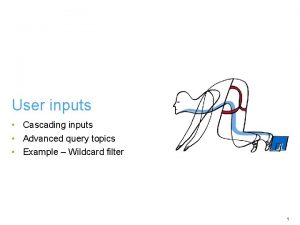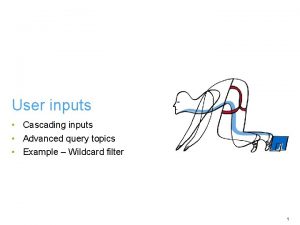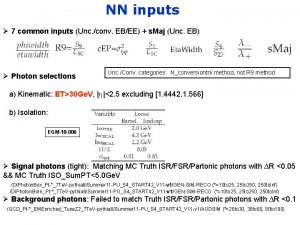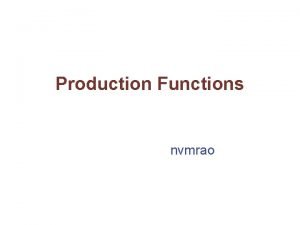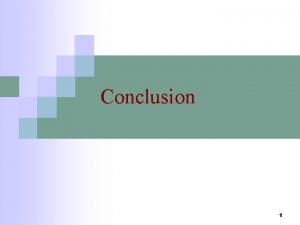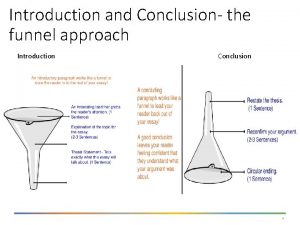Lecture 11 a Inputs and Production Functions conclusion






























- Slides: 30

Lecture # 11 a Inputs and Production Functions (conclusion) Lecturer: Martin Paredes

1. 2. Returns to Scale Technological Progress 2

Definition: Returns to scale is the concept that tells us the percentage increase in output when all inputs are increased by a given percentage. Returns to scale = % Output. % ALL Inputs 3

Suppose we increase ALL inputs by a factor l Suppose that, as a result, output increases by a factor . l Then: 1. If > ==> Increasing returns to scale 2. If = ==> Constant returns to scale 3. If < ==> Decreasing returns to scale. l 4

K Example: Returns to Scale K 0 • Q 0 0 L 5

K Example: Returns to Scale • K 0 • Q 0 0 L 0 L 6

K Example: Returns to Scale • K 0 Q 0 • Q 0 0 L 0 L 7

K Example: Returns to Scale If > , then we have Increasing returns to scale • K 0 Q 0 • Q 0 0 L 0 L 8

K Example: Returns to Scale If = , then we have Constant returns to scale • K 0 Q 0 • Q 0 0 L 0 L 9

K Example: Returns to Scale If < , then we have Decreasing returns to scale • K 0 Q 0 • Q 0 0 L 0 L 10

Notes: l When a production process exhibits increasing returns to scale, there are costs advantages from large-scale operation. l Returns to scale need not be the same at different levels of production 11

Note: l Substantial difference between returns to scale and marginal product: l Returns to scale: All inputs increase in same proportion l Marginal product: Only one input increases, while the others remain constant l Therefore, it is possible to have diminishing marginal returns and increasing/constant returns to scale. 12

Example: Returns to scale Suppose a Cobb-Douglas utility function: Q 1 = AL 1 K 1 ==> Q 2 = A( L 1) ( K 1) = + AL 1 K 1 = + Q 1 Hence, returns to scale depends on the value of + . If + = 1 ==> Constant returns to scale (CRS) If + < 1 ==> Decreasing returns to scale (DRS) If + > 1 ==> Increasing returns to scale (IRS) 13

Definition: Technological progress shifts the production function by allowing the firm to: 1. Produce more output from a given combination of inputs, or 2. Produce the same output with fewer inputs. 14

l Three categories: 1. Neutral technological progress 2. Labor-saving technological progress 3. Capital-saving technological progress 15

Definition: Neutral technological progress shifts the isoquant inwards, but leaves the MRTSL, K unchanged along any ray from the origin l In other words, for any given capital-labor ratio, the MRTSL, K remains unaffected. 16

Example: Neutral technological progress K Q = 100 before K/L L 17

Example: Neutral technological progress K Q = 100 before Q = 100 after K/L L 18

Example: Neutral technological progress K Q = 100 before Q = 100 after MRTS remains same K/L L 19

Definition: Labor-saving technological progress results in a decrease in the MRTSL, K along any ray from the origin 20

Example: Labor Saving Technological Progress K Q = 100 before K/L L 21

Example: Labor Saving Technological Progress K Q = 100 before Q = 100 after K/L L 22

Example: Labor Saving Technological Progress K Q = 100 before Q = 100 after MRTS gets smaller K/L L 23

Definition: Capital-saving technological progress results in an increase in the MRTSL, K along any ray from the origin 24

Example: Capital-saving technological progress K Q = 100 before K/L L 25

Example: Capital-saving technological progress K Q = 100 before Q = 100 after K/L L 26

Example: Capital-saving technological progress K Q = 100 before Q = 100 after MRTS gets larger K/L L 27

Example: Technological Progress Before: Q = 500 (L + 3 K) MRTSL, K = MPL = 500 = 1 MPK 1500 3 After: Q = 1000 (0. 5 L + 3 K) MRTSL, K = MPL = 500 = 1 MPK 3000 6 Since MRTSL, K has decreased, technological progress is laborsaving 28

1. Production function is analogous to utility function and is analyzed by many of the same tools. 2. One of the main differences is that the production function is much easier to infer/measure than the utility function. Both engineering and econometric techniques can be used to do so. 29

3. Technological progress shifts the production function by allowing the firm to achieve more output from a given combination of inputs (or the same output with fewer inputs). 4. Returns to scale is a long run concept: It refers to the percentage change in output when all inputs are increased a given percentage. 5. The production function is cardinal, not ordinal 30
 Post production workflow diagram
Post production workflow diagram Production with two variable inputs
Production with two variable inputs Marginal rate of technical substitution
Marginal rate of technical substitution Production with two variable inputs
Production with two variable inputs 01:640:244 lecture notes - lecture 15: plat, idah, farad
01:640:244 lecture notes - lecture 15: plat, idah, farad Inputs and outputs of calvin cycle
Inputs and outputs of calvin cycle What are the inputs and outputs of system design?
What are the inputs and outputs of system design? Output of mrp
Output of mrp Citric acid cycle input and output
Citric acid cycle input and output Glycolysis inputs and outputs
Glycolysis inputs and outputs Human input output channels in hci
Human input output channels in hci In a banyan switch for 8 inputs and 8 outputs we have
In a banyan switch for 8 inputs and 8 outputs we have Direct and manage project work
Direct and manage project work Overland flow
Overland flow Inputs outputs transformation processes and feedback
Inputs outputs transformation processes and feedback Improving productivity at starbucks
Improving productivity at starbucks Module 2 the animal world
Module 2 the animal world Aggregate planning inputs and outputs
Aggregate planning inputs and outputs Fmea inputs and outputs
Fmea inputs and outputs Inputs and outputs
Inputs and outputs Inputs and outputs
Inputs and outputs When demand is unlimited and products use the same inputs
When demand is unlimited and products use the same inputs What are the inputs to and outputs of a supply chain
What are the inputs to and outputs of a supply chain Water cycle
Water cycle Inputs of light reactions in photosynthesis
Inputs of light reactions in photosynthesis Reactants in photosynthesis
Reactants in photosynthesis Inputs to mrp
Inputs to mrp Inputs de una empresa
Inputs de una empresa Sfas 142
Sfas 142 Inputs to develop project charter
Inputs to develop project charter Inputs, activities, outputs, outcomes
Inputs, activities, outputs, outcomes

